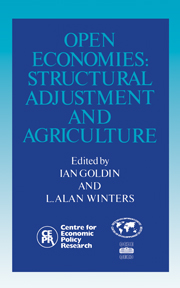Book contents
- Frontmatter
- Contents
- List of figures
- List of tables
- Preface
- Acknowledgements
- List of conference participants
- 1 Introduction: from macro to maize
- Part One Open economy analysis
- 2 Sequencing and welfare: labour markets and agriculture
- Discussion
- 3 Agricultural adjustment and the Mexico-USA free trade agreement
- Discussion
- 4 Do the benefits of fixed exchange rates outweigh their costs? The CFA Zone in Africa
- Discussion
- 5 Adjustment and the rural sector: a counterfactual analysis of Morocco
- Discussion
- Part Two The small country assumption and trade reform
- Part Three Risk and adjustment
- Part Four Government's role
- Index
2 - Sequencing and welfare: labour markets and agriculture
from Part One - Open economy analysis
Published online by Cambridge University Press: 04 August 2010
- Frontmatter
- Contents
- List of figures
- List of tables
- Preface
- Acknowledgements
- List of conference participants
- 1 Introduction: from macro to maize
- Part One Open economy analysis
- 2 Sequencing and welfare: labour markets and agriculture
- Discussion
- 3 Agricultural adjustment and the Mexico-USA free trade agreement
- Discussion
- 4 Do the benefits of fixed exchange rates outweigh their costs? The CFA Zone in Africa
- Discussion
- 5 Adjustment and the rural sector: a counterfactual analysis of Morocco
- Discussion
- Part Two The small country assumption and trade reform
- Part Three Risk and adjustment
- Part Four Government's role
- Index
Summary
Introduction
In the early 1990s the economics profession came to virtual agreement regarding the advantages of economic policies that favour openness and export growth. The decades-old debate regarding inward- vs. outwardorientation seems to have been won by the proponents of outwardoriented policies. The arrival at this quasi-consensus has, however, generated a score of important and pressing questions regarding the actual implementation of outward-oriented policies. Perhaps the questions that have attracted the greatest attention of policy makers and economic analysts are the ones related to the sequencing and speed of structural reform: In what order should different markets be liberalised? Should a country tackle the inflationary problem before dealing with market-oriented reforms, or should the opposite sequence be pursued? How costly is it to undertake liberalisation reforms if the labour market is still regulated and distorted? What is fascinating is that every day it becomes clearer that these issues are not only of relevance to the developing nations, but that they are increasingly important – crucially vital, we may even argue – for those East European countries currently engaged in reform and restructuring. In fact, it is not an exaggeration to say that in policy circles throughout the world there is a sense of urgency regarding issues of sequencing and speed of reform.
Although questions related to sequencing and speed, such as the ones posed above, are faced every day by policy makers and their advisors, the academic literature on the subject has been sparse and somewhat diffuse.
- Type
- Chapter
- Information
- Open EconomiesStructural Adjustment and Agriculture, pp. 15 - 39Publisher: Cambridge University PressPrint publication year: 1992



